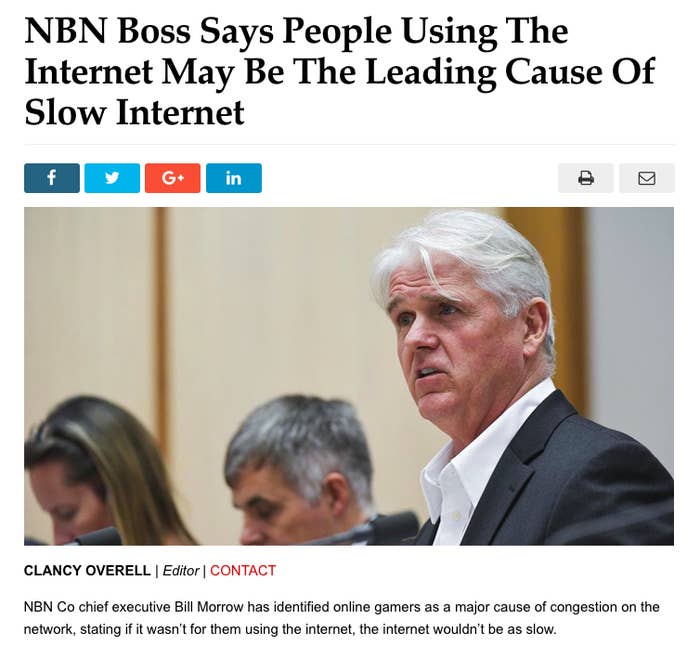
NBN has a problem with its wireless service provided to regional and remote parts of Australia: too many people want to use it to access the internet.
The internet in Australia collectively lost it on Monday when NBN CEO Bill Morrow was asked at a parliamentary committee hearing about a policy to "shape" (throttle) the speeds for people on the fixed wireless service, in a bid to cut down on congestion on the service for everyone.
According to the ABC, Morrow said "gamers, predominantly" would be affected if NBN started shaping the bandwidth on fixed wireless during peak hours.
"While people are gaming it is a high bandwidth requirement that is a steady streaming process," Morrow said.
"This is where you can do things, to where you can traffic shape — where you say, 'No, no, no, we can only offer you service when you're not impacting somebody else'."
This was picked up by news.com.au, SBS, and a variety of gaming and tech sites, in what some were calling NBN's own "Gamer Gate".
It peaked with satirical publication Betoota Advocate getting to the nub of the issue with this headline:

NBN has been in a bit of damage control since then, and pointed to Morrow's subsequent comments in the committee where he clarified that "super users" consuming "terabytes of data" were the ones that would likely be affected by shaping.
The problem is isolated to the fixed-wireless network, which is available to around 600,000 premises in regional and remote parts of Australia. Currently around 240,000 people are connected.
On the fibre to the premises, hybrid fibre coaxial, and fibre to the node portions of the network, where the majority of people in Australia will connect to the internet, the number of people on the network in peak hours should not be that much of an issue. That is, provided the connection isn't bad (which for FttN people it may well be) and the internet service provider buys enough bandwidth.
On wireless, though, because it is, well, wireless, there is limited capacity for each tower built around the country. If Morrow's so-called "super users" are downloading terabytes of data every month, then that limits the speed for everyone else on that particular tower.
The problem is that for many of the people in these regional and remote areas, prior to the NBN's arrival, they had been on some of the worst internet connections in Australia, if they were able to connect at all. And now that they can see what is on offer, some of them are using it. A lot.
In about .5% of the areas covered by fixed wireless, usage means the minimum speed NBN can offer is 3Mbps. For around 7% it is just 6Mbps.
"That means that for a certain number of customers, during the evening hours, which is when the busy time would be there, they could be restricted to six megabits per second," Morrow told Senate Estimates last month.
NBN doesn't have a breakdown of data usage on fixed wireless alone but NBN data usage provided to BuzzFeed News by the company for all of its technologies shows the average download per month for users has gone from 137GB per month in June 2016, to 191GB per month today.
Despite Morrow's initial claim, most of those who are using the most bandwidth aren't actually gamers. They're more likely people who are either torrenting or streaming lots of things.
There's no point in NBN spending more on fixed wireless to meet the demand of those users. Currently it costs about $4,000 per home to install fixed wireless, while fibre to the node is about $3,000. People in the cities are already subsidising the cost for people in regional and remote areas, and any upgrade or switch to a different technology would be very expensive.

In Senate Estimates last month, Morrow said fixed wireless had "always been a negative in terms of profitability" and upgrading it would only make it worse.
"It doesn't matter if we offered the higher 50 or 100 or multiple hundred speeds. It's not about making money in these areas. The losses we see in these wireless technology areas are offset by the profits that we make in the city centres."
NBN has spent $2 billion to date on the fixed wireless network, and Morrow said "billions more" would have to be spent to allow everyone to have the top 100Mbps speed, which NBN had decided against offering to fixed wireless users.
So NBN faces a difficult choice. Does the company punish people for using the internet as it is intended to be used, or does it make the experience worse for everyone on fixed wireless?
Or does it spend more money on the network to upgrade it for everyone and blow out the cost of the NBN, threatening return on investment?
NBN spent $207 million in the last six months on improvements, but it might not be enough. In its blog post yesterday, NBN said it was looking at the options.
"For [towers] that have a higher degree of congestion, we are actively engaging with retailers to provide them with information so that end-users can be kept informed," the company said.
"We are also actively monitoring the end-user experience and we continue to look at all our options to respond to increasing demand."
